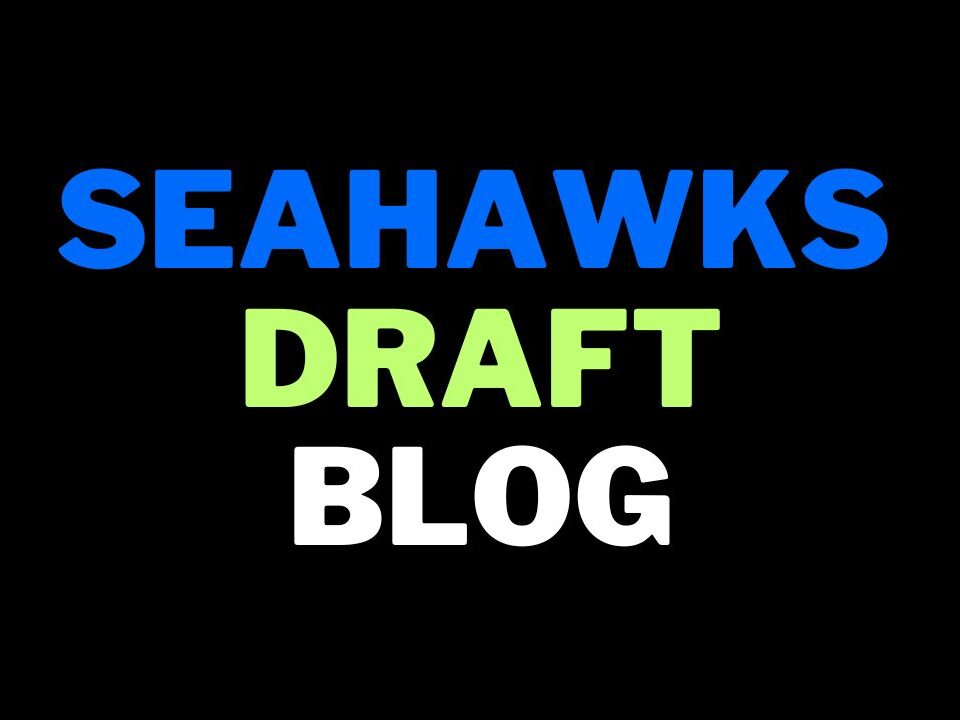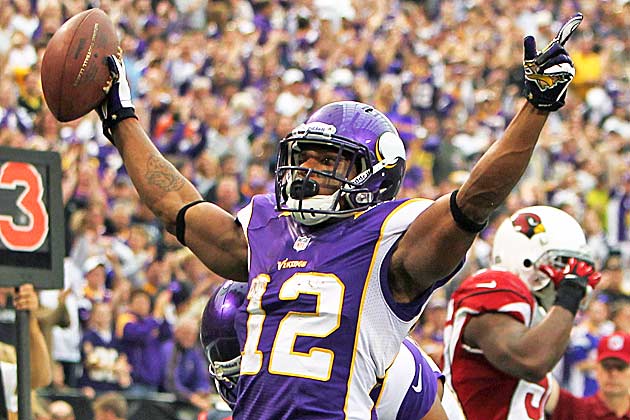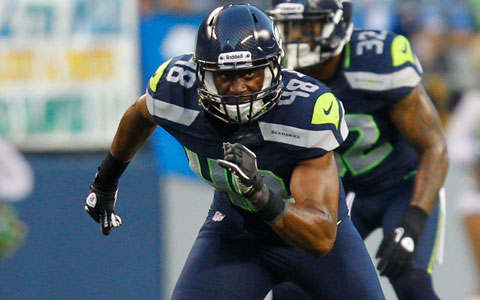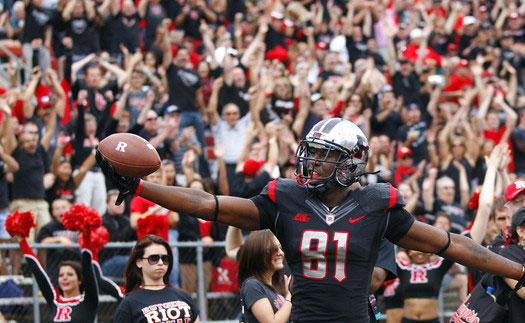It’s funny how memory works. One of the impressions I had from Seattle’s meeting against Minnesota last year was how unstoppable Harvin seemed. Earlier today, I looked at Harvin’s game log to see how he did. He had 10 yards receiving on six targets. He added 24 yards on 4 rushes. Was I smoking crack? Why did I think Harvin was carving us up?
After reviewing that game a bit more, I realized how many close calls our defense had against Harvin. Passes that just missed, passes caught that were just barely contained, and rushes that might have gone big if not for an ankle tackle here and there. He may not have had a great game statistically before leaving with injury, but Seattle didn’t have the speed to cover him. If he had been paired with a better quarterback and if he had played the whole game, I suspect he would have been a nightmare for our defense. Harvin was on pace for 1334 receiving yards on 120 receptions before that fateful game at Century Link. There was talk around midseason that he could end up an MVP candidate.
Pete Carroll once called Harvin “arguably the best football player in America” in reference to Harvin as a recruit from Landstown High School in Virginia. The competition for Harvin as recruit came down to just USC and Florida. Carroll made a big push, but ultimately lost Harvin to Florida, probably because Harvin wanted to stay on the east coast. I don’t think Carroll ever forgot about Harvin. If there is one thing you can count on- it’s that Pete Carroll doesn’t forget the one that got away. Marshawn Lynch, Richard Sherman, and Bruce Irvin can testify to this. Now Percy Harvin can as well.
But just as importantly, I think Harvin had a special place in John Schneider’s heart as well. In Green Bay- where Schneider served as Thompson’s right hand man for many years- they had tremendous success in the draft with receivers. They followed a system that targeted fast receivers with quick feet and yards after catch ability.
In Seattle, that trend continued, with the team targeting quick receivers like Golden Tate and Kris Durham, as well as acquiring Doug Baldwin, Jermaine Kearse, Ricardo Lockette and Phil Bates, all of whom ran in the 4.4’s or better. The slowest receiver Schneider has acquired from the draft process is Lavasier Tuinei, and even he ran a 4.53. The two biggest successes of that group are Tate and Baldwin. Tate is famous for his ability after the catch, and Baldwin is no slouch himself. A very common comparison for Tate is a poor man’s Percy Harvin.
After a pair of sneaky strong 2012 seasons from Golden Tate and Sidney Rice, it made sense that Seattle would target an upgrade in the slot over Doug Baldwin, who finally showed the same struggle to remain healthy that made him an otherwise undeserving undrafted free agent in 2011. Harvin led the NFL in yards after catch per reception last season, and has the kind of rare quickness out of the slot that you will only find a few other places in the league. Not only did Harvin’s profile perfectly fit Seattle’s preferences, but his ability as a slot weapon, kick returner, and wrinkle in the rushing attack fit perfectly into Seattle’s 2013 offseason needs.
Harvin also brings an added element: he changes the way defenses have to game plan our offense. Consider this video where Vikings offensive coordinator Bill Musgrave talks about the impact Harvin has on defensive formations:
http://www.youtube.com/watch?v=ji9kxcbjimM&feature=youtu.be
Harvin’s speed and threat after the catch will not only limit the number of looks defenses can show pre-snap, but it will also force defenses to cover him in the slot with safeties and corners. If you have a corner on him, that probably means using a nickle defense package. Nickle packages tend to fare worse against the run, which is pretty nice considering that Seattle led the NFL in rushing percentage last season. If you cover Harvin with a safety and are not using a nickle package, that means you only have one safety deep, which invites big plays on the deep ball. If memory serves, Russell Wilson was the 4th highest quarterback in the NFL last season in deep ball throw rate.
It’s very unlikely that Harvin would post 120 catches for 1334 yards in our offense next year. However, even if he posts Sidney Rice or Golden Tate type production, Harvin could bring a lot of hidden value to the rest of the offense based on his ability to change the way defenses play.
Regarding the trade itself, I don’t think it was a bad trade by any means, but I do think Seattle overpaid. It was widely assumed just one month ago that Minnesota had no leverage and would be fortunate to get a 2nd or 3rd round pick. One anonymous NFL GM even went so far to say that he’d be “shocked” if Minnesota even managed a 3rd. I think Harvin’s $11 million a year contract is reasonable, but it is still a lot of money to invest at receiver in an offense that spreads the football. And as Kenneth Arthur recently noted, Seattle owns the NFL’s most expensive offense, despite having a star quarterback making about 1/40th what he deserves.
Even the 7th round pick Seattle surrendered shouldn’t be taken lightly in this loaded draft class. It’s very possible that the draft picks alone could have turned into two or three good players, and then you have the money aspect which would cover two more good players as well. So for the price of one Harvin, Seattle gave up four or five contributors- and there is a chance one or two of them could be the next Richard Sherman or Bobby Wagner. That’s a lot to give up.
Of course, Seattle’s roster is so stocked right now that many draft picks are going to waste anyway, but I don’t think that should be used as an excuse. You always need more young talent to come in to replace the previous young talent that will inevitably lost to free agency in the coming years.
That said, I also thought Zach Miller was an overpay, and I couldn’t be any happier to have Zach Miller on my team. I think everyone agrees that Joe Flacco is overpaid, but Baltimore is far better off with an overpaid Joe Flacco than without him. Being an overpay does not make the Harvin transaction a burden by any means. Quite the opposite, I think Seattle just got their version of Wes Welker. The Patriots got Welker for a 2nd and a 7th, and a lot less money, but had they paid a Percy Harvin type price, they obviously wouldn’t have regretted it. Not that I expect Harvin to post Welker type numbers, but I do think our offense will have a comparable leap forward.
Another trade comparison is Julio Jones. The Jones trade cost far more in picks (two firsts, a second, and two fourths), but Harvin cost $7 million more a year in salary. Even at the steep cost of the Jones trade, most people agree that the deal has been justified by Jones’ performances. I don’t think Harvin is the kind of pure receiving threat that Jones is, but in terms of total contribution (receiving, rushing, special teams, the way he changes defenses) I think it could be argued that he’s at least in the ballpark for total value.
I don’t think this trade proved anything about Seattle’s priorities. They could have acquired players like Greg Jennings, Mike Wallace, or Wes Welker for far less total cost. The fact that they paid this much with some excellent cheaper alternatives just shows you how highly they value Harvin. They clearly view Harvin as a 24 year old, MVP type difference maker for their offense. I don’t think this was a case of buying high because of a need. I think it was a case of buying high because they felt that Harvin specifically was a “must get” player.
Of course, all the worries about Harvin’s migraines and character risks shouldn’t be brushed aside (although to be fair, Harvin busts his ass on the field and is exactly the kind of “character risk” that would fit in around here). We’ll see how that works out with time. If nothing else, Seattle’s emphatic trade for Harvin crystallizes the idea that Seattle highly values speedy, yards after catch receivers.
John Schneider loves black sheep free agents
John Schneider’s modus operandi in free agency has always been “wait and see.” In 2011, he made a shocking acquisition of Sidney Rice on day four of free agency. Rice, a one time 1300 yard receiver, drew essentially no interest in the open market. Seattle saw an opportunity for a potential #1 receiver on a reasonable deal, and pounced. A few days later, more than a week into free agency, Seattle made an even bigger surprise signing with Zach Miller, who had far less interest than expected on the open market. The deal for Miller wasn’t the potential bargain that Rice was, but Seattle was hunting for talent for their two tight end sets and Miller fits our multi-dimensional offense about as well as you could ask for.
In 2012, Seattle seemed disinterested in quarterback Matt Flynn, that was until his market didn’t materialize as many expected. Teams avoided Flynn, unconvinced by his lack of track record and late round tools. It probably didn’t help that everyone just assumed he’d get “Kolb money”, this during a time when Kevin Kolb was considered a cautionary tale. Flynn ended up with almost zero market, and Seattle’s view changed. They ended up swooping in to nab him at 3 years, $19 million, a move that probably would have looked brilliant if not for the thunderous emergence of Russell Wilson.
Of course, this tactic extends beyond big money darlings in free agency. Black sheep come in all shapes and sizes. Guys like Brandon Browner, Chris Clemons, Marshawn Lynch, Leon Washington, Raheem Brock, Brandon Stokely, Anthony Hargrove, Kellen Winslow, Terrell Owens, and Braylon Edwards. Some of those acquisitions were strikeouts and some were home runs, but all were low cost gambles that on the whole provided the team with a great return on investment.
This year’s black sheep acquisition is Cliff Avril. Widely believed to be the top pass rusher available, Avril did not generate the market that was expected. Perhaps citing a lack of run defense, or the theory that Ndamukong Suh acted as Avril’s benefactor, teams seemed wary to hand Avril top pass rusher years and money. With Clemons being paid nearly $18 million for his age 32 and 33 seasons, coming fresh off an ACL, and with Irvin appearing to be far away from being a true 3-down LEO, adding another pass rusher at end made all kinds of sense for Seattle at the right price. It’s no surprise then that Seattle was the first team to invite John Abraham for a visit after his release from the Falcons.
When it was announced that Seattle had signed Avril, I was surprised. When I saw the details, I was stunned. Fifteen million dollars over two years? Seriously? What a great buy low move and as early as day two of free agency no less.
Avril’s game is a bit of a mix between Chris Clemons and Bruce Irvin. Avril’s size, speed, and physique is extremely similar to Clemons. And like Clemons, Avril can manage against the run without having to sell out for it. Where he’s like Irvin is how he’s very much an edge rusher that isn’t the same on inside moves. Avril thrives on attacking the edge and swatting at quarterbacks as he passes by. This is where I think the Suh concern is very real, because most of Avril’s production occurs because quarterbacks are afraid to step into the pocket. And without a 1st round pick, or any real answer in free agency, Seattle will find it very challenging to create interior pressure next season. Of course, Seattle is not done with the offseason, and there are a few rays of hope in the 2013 draft to complete Seattle’s pass rush ((cough) John Simon (cough) (cough)).
For many teams, I don’t know if Avril made sense even at 2/15, but for Seattle’s LEO role he’s a great fit. I would have happily seen the Seahawks sign him for 5/50 last offseason before he was franchised. Our defense is built to minimize his issues against the run, and while we probably won’t generate the interior pressure he’s depended on, he didn’t exactly have a secondary quite like ours behind him in Detroit, either.
Of course, this acquisition raises questions about Chris Clemons’ future. Will Seattle pay almost $18 million over the next two seasons for a 32 year old player fresh off an ACL when cheaper, safer, and frankly, better alternatives are available? Clemons has been one of the most valuable defensive ends in the NFL, but I doubt he’d bring as much value in 2013 on a bad knee as a healthy John Abraham or Osi Umenyiora would. Is a healthy 26 year old Cliff Avril worth less than a 32 year old Clemons fresh off an ACL? With Avril acting as needed insurance, we might see a restructure attempt heading Clemons’ way.
Obviously, nobody expected Seattle to blow the doors off in the first two days of free agency. But in retrospect, their actions seem almost predictable for how well they fit the established mold. While the amount is shocking, the fact that Seattle went for Percy Harvin is hardly surprising. While it was highly unexpected that Avril would find his market so lacking, it is not surprising that it was the Seahawks who took advantage of it. So far, this has been nothing if not a very John Schneider type offseason. The Seahawks do not handle free agency like most teams do, and it’s part of the reason they’ve risen so quickly as an NFL superpower.









